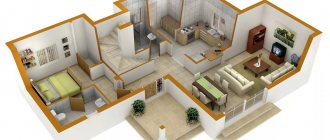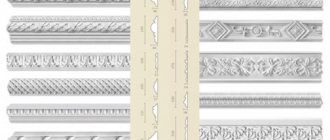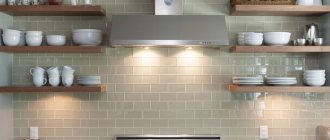Installation of appliances in the kitchen
Equipment manufacturers are constantly releasing new equipment with improved characteristics. Of course, consumers constantly update their equipment by purchasing more modern ones. First of all, when you buy a new device, you need to find a place for it .
At the same time, it is necessary to ensure not only the convenience and safety of using the stove, but it must also be harmoniously combined with other household appliances and furniture. It seems that a microwave oven cannot take up much space and can be placed next to other devices in any convenient place, but this is not so. If the kitchen is small, there may be problems with the placement of the appliance. However, you can hang the device on a shelf.
If a microwave is purchased for a kitchen that is equipped with a large number of household appliances, then it is sometimes simply difficult to fit it with other appliances.
Furnace location
After purchasing a microwave, many begin to wonder where it is best to put it. It is worth noting that you cannot install a microwave oven in all corners of the kitchen. Before placing it on the refrigerator, you should think about how compatible the two devices are, since one heats up and the other cools.
Before placing a microwave on top of your refrigerator, you need to ask yourself the following question: Will this affect the efficiency of both devices?
Many users of microwave ovens claim that the device can stand on the refrigerator for many years, working efficiently .
Their statement can be justified by the fact that both devices can be classified as isolated. This means that external factors cannot affect the performance of the devices.
How to position equipment correctly
When choosing the right location for the TV in the kitchen, you should also follow these simple rules.
- Do not place the device next to the sink. If liquid gets on the surface of the TV, it can not only cause equipment failure, but also cause an accident.
- There is no need to place the TV near heat sources (electric or gas stove, heating radiator, etc.). You should also protect it from direct sunlight. This will avoid overheating and premature wear of device parts.
- When choosing a TV for the kitchen, it is better to give preference to medium-sized models (up to 20 inches). Such a TV will easily fit even into a small kitchen, without causing unnecessary hassle or inconvenience to the owners.
- The TV should not be placed too high. The optimal height should not exceed two meters, otherwise the user will experience discomfort when viewing due to excess strain on vision and the cervical spine.
Modern manufacturers of household appliances offer refrigerator models with built-in LCD TVs. This technique is convenient, ergonomic and a great space saver in the kitchen, however, it costs an order of magnitude more than its analogues, purchased separately. The home appliance market also offers refrigerators with an opening for installing a TV.
You just need to choose a device that is suitable in size. To do this, it is better to contact specialists at a household appliance store. A good solution would be to place it in a special niche provided in the kitchen set. In this case, you will need to install a shelf under the device in the opening and consider the close location of the sockets.
If all of the above methods are not suitable, and you really need a TV in the kitchen, you can place it on the refrigerator. There are no categorical prohibitions on this, and service center specialists claim that there have not yet been any cases of breakdowns of household appliances due to a negative impact on each other.
Microwave on refrigerator
A microwave oven is an important thing. To heat or cook food, you use it several times a day, so the equipment should be accessible to all family members and be at a comfortable height. But all the installation recommendations are only good for reheating food and defrosting food, and not for using the oven at full power for a long time when cooking . In this case, it is not recommended to place it on the refrigerator for reasons of safety for the whole family.
We'll have to look for another place.
And, most likely, these will be special brackets for mounting on the wall. They just don’t put large, modern stoves on hooks. When installing a microwave device on a refrigerator, you need to remember that if any of these two units breaks down, warranty repairs may be denied. Most modern microwave devices have an internal fan .
It forces hot air to circulate throughout the chamber, which speeds up the cooking process. Some of this air mass from the microwave oven passes through holes that are located in different models on the back, bottom or side surface of the case. This escaping hot air is a serious problem. If the holes are blocked, the microwave oven may quickly overheat and fail. It is recommended to install it so that there is a space of 15-20 cm around it; only with proper installation, heat will be removed from the devices, without creating preconditions for overheating of the equipment.
Heat flows into the kitchen come not only from the microwave oven. The condenser grille at the rear of the refrigerator also generates some heat. Taking this into account, appliance manufacturers do not recommend placing a microwave oven on a refrigerator. However, much depends on how often you use the microwave. The refrigerator runs continuously, but the microwave only turns on occasionally.
Can I put anything in the microwave? If the microwave is used for home cooking with long operating cycles of 30-60 minutes or more, it must be installed in an open area. Even a small refrigerator or freezer can support the weight of the microwave, there are no problems from that side. The main obstacle to refrigerator installation is the heat that is generated during the cooking process . He must somehow get rid of it, otherwise this technique will not work for a long time.
Posting rules
In order to ensure that the use of these electrical appliances is comfortable for users and safe for the equipment itself, the following conditions must be met:
- Constant ventilation. Some microwave ovens have ventilated holes not only on the sides of the cabinet and on the back wall of the device, but also on the bottom panel. This means that to ensure maximum ventilation efficiency of this device, you need to take care of free air access to the bottom panel of the microwave. Firstly, the device must be equipped with legs so that the bottom wall is ventilated and suspended. The absence of legs can lead to overheating of the device and, consequently, its possible breakdown. Secondly, the surface on which the microwave will be installed must be hard, preferably made of a material that has thermal insulation properties. So materials such as a tablecloth, newspaper or blanket are definitely not suitable here. You also need to take into account the established distances that should separate the device from the walls and ceiling: 12 cm to the wall and 20 cm to the ceiling.
- Convenient operation. When placing a microwave oven on a refrigerator, you need to take into account the height of the latter, since many models of refrigeration devices can reach 2 meters. Placing a microwave oven on such a refrigerator is hardly reasonable, since to use the device for its intended purpose (heating food) you will have to place a chair or stepladder. Agree, it’s not very convenient, especially if you’re heating a bowl of soup. This creates an unnecessary opportunity to spill or get burned. In addition, with a refrigerator of such a height, you are unlikely to be able to maintain the required distance between the device and the ceiling.
We suggest you familiarize yourself with what a pressure switch looks like in a washing machine
The optimal location for the microwave oven is at a height just below the user's shoulders. Following established standards, the device must be installed between 90 cm from the floor surface and 150 cm. This is considered a safe height.
- Frequency of use. Provided that the microwave will be used for defrosting semi-finished products and heating ready-made dishes, there are no restrictions for installing it on the refrigerator, since these operating modes are short-lived. If the use of this device for preparing the dishes itself will take a longer amount of time, during which the device will release a huge amount of thermal energy, which can affect the operation of the refrigeration condenser, which can disrupt the basic properties of the refrigeration device. Using a microwave oven this way can lead to increased electrical energy consumption and reduced operating time of the refrigerator. In such conditions, it is better to refrain from placing a microwave oven on the refrigerator compartment and try to avoid such proximity.
- Current protection. The instructions for any microwave oven state that the device must be grounded. Since the food heating device and the refrigerator will come into contact in one way or another, you need to make sure that both of these devices are connected to special sockets equipped with grounding.
It should also be noted that the location of the microwave oven directly on other household appliances allows service organizations to refuse even repairs under the warranty of these devices.
Microwave oven on refrigerator and freezer
The instructions for some models clearly indicate the inadmissibility of placing microwave ovens on refrigerators and freezers, since it is not recommended to install various objects on these devices. Can a microwave be placed on a refrigerator? Can a microwave be placed in the freezer? These are not the best places to install. Owners are forced to do this in a small kitchen when it is difficult to find another place.
Why can't you put a microwave in the refrigerator compartment ? Flaws:
- Vibration of refrigeration equipment may lead to the microwave moving and falling;
- Modern refrigerators are often tall, awkward to place, and getting food can cause burns;
- Only heating and defrosting of food is possible. You can cook in an oven, but during operation it has a bad effect on the refrigerator and on the electronic panel of the appliance;
- Connecting two devices to one outlet will create a large load on the network;
- The microwave is heavy and can push and damage the top of the refrigerator. To avoid various consequences, it is necessary to separate the microwave device and the refrigerator.
Advantages:
- Possibility of freeing up space in a small kitchen;
- All equipment in one place.
Install the microwave on the refrigerator only as a last resort when no other installation option is available, and use it with caution.
Seal wear
In addition to malfunctions in the operation of the refrigerator and freezer compartments, installing the refrigerator in an unheated room is fraught with deformation of the sealing rubber. Due to temperature changes (for example, heating under the sun's rays on the balcony and cooling at sub-zero temperatures in winter), the elastic band stretches and cracks - this causes the refrigerator to lose its seal. This causes warm air to get inside, the sensors produce incorrect values, and the refrigerator begins to work more actively to bring the temperature back to normal. This causes the motor to wear out and become vulnerable to breakdowns.
Seal wear
A refrigerator is not a household appliance that is profitable to change frequently, which means you need to treat it with the utmost care and extend its service life by all means. When considering whether or not to install a refrigerator in an unheated room, it would be optimal to find a more suitable place for installation or to take care of maintaining a comfortable temperature for the correct operation of the compressor.
If you discover a breakdown and are sure that it is not related to a power outage or other easily fixable problem, then you should immediately call a technician to your home. Refrigerator repair in Grodno is professional, prompt and high-quality.
Safety in use
Of course, microwaves are safe to use. But no one is immune from injuries that can be caused by improper use. What does the user need to know to avoid unpleasant incidents? Do not forget to read the instructions before starting to work with the equipment.
Instructions:
- The microwave oven is a food preparation device and should not be used for other purposes.
- Never use an empty microwave oven.
- If you have a damaged cord or plug, it will need to be replaced. Using household appliances under these conditions is prohibited and dangerous.
- If you notice a malfunction, contact a technician; do not try to fix the microwave oven yourself.
- Place the microwave so that children cannot reach it.
- Do not leave food in the oven.
- Be careful with liquid hot food.
- Do not heat vacuum packed products. This may cause an explosion.
Improper use of the microwave can not only lead to short circuits, but also to fire. To avoid this, it is strictly forbidden to use metal or low-quality kitchen utensils for the microwave.
Rules for installing a microwave on a refrigerator
The microwave can be placed on the refrigerator, if you take into account some features of the device. If possible, it is better to prepare a place for the kitchen assistant, not close to the wall. Otherwise, failure to comply with the rule will lead to failure of one or both devices, and the price of new equipment or compensation for repairs and maintenance will hit your pocket hard.
There are several important rules that must be followed when installing a microwave on a refrigerator.
They are as follows:
- In many microwave devices, ventilation holes are located on different sides. If the microwave is located on the refrigerator, then it must stand on special legs so that the space necessary for ventilation remains between the device and the countertop. If there are no feet, or if the space between the bottom of the oven and the refrigerator is clogged with some kind of debris, then ventilation is ineffective, and this can lead to failure of the device.
- Also, there should be no materials such as oilcloth or paper between the microwave and the refrigerator. It is better to place the microwave on a sheet of plywood or any other material that can serve as an insulator.
- Whether you can install an oven on a refrigerator will depend on how high your refrigeration equipment is. If the refrigerator is two meters high, then placing it on the microwave is impractical and even dangerous. Firstly, the gap between the ceiling and the stove must be at least 20 cm, which relates to ventilation. Secondly, the high position of the microwave will lead to health risks. Imagine that you are heating a bowl of soup in the oven, and when you take it out from above, you can spill hot broth on yourself and get burned.
- Consider how often you use the microwave oven and how long you use it for. If you turn on the device several times a day for five minutes, then it’s okay. If you work with it for several hours a day, then it is better not to install it on the refrigerator.
Pros
- I want to take up the empty space on top of the refrigerator, I want to decorate a boring unit.
- There is no more space, but somewhere you need to put some indoor flowers.
- It is necessary to move the plant higher to protect it from small children or, on the contrary, to protect children from contact with possible plant allergens or sharp thorns (as is the case with cacti).
- You may want to move the flowers to the refrigerator, since it is in a place where there are no drafts and optimal lighting, but on the kitchen windowsill there are either drafts, or direct rays of sunlight, or another negative factor.
If the refrigeration unit is located in a secluded place, where there is enough light from the window, there are no drafts, no steam or smoke from the stove, then this may indeed be a good place for growing indoor plants.
Practice has shown that vibration from the refrigerator does not interfere with plants. On the contrary, it shakes the earth and improves the movement of air and water.
Best accommodation options
Installing a microwave in the kitchen must meet certain requirements.
If space permits, give the oven its own place away from other appliances. For example, it is not recommended to place it near the TV. The best option would be to install special brackets on the wall. These are mounts that allow you to place the stove on the wall in any convenient place. You can buy them at any hardware store, but if you want, you can make them yourself.
If this is not possible, then the microwave can be placed on the surface of kitchen cabinets or a windowsill. The main thing is that the surface is flat, the stove stands on it completely, without hanging, and there is enough space for everything around to extract hot air.
It is highly undesirable to place a kettle on a microwave: the oven body is not designed to bear the load, so heavy objects are not needed there.
In each case, the conditions under which the devices will operate must be taken into account. When choosing a location to install your microwave, you want it to be accessible, have doors that open easily, and be easy to use. If you have small children, then placing the microwave at a height is undesirable.
Allowed options for mounting a TV above the refrigerator
Modern, flat and lightweight, the TV can be attached anywhere in the kitchen using specialized fasteners. Such hangers can be purchased in every store that sells household appliances. Fasteners may vary in type and cost. There are four most common fastener options:
We recommend reading:
Can a microwave be placed on a refrigerator?
Is it possible to place a refrigerator next to an electric or gas stove?
Features of transporting refrigerators
- Fixed - tilting and turning the equipment is eliminated, and the cost of such fasteners is low.
- Tilt-and-rotate – make it possible to adjust the tilt of the equipment so that the image is not distorted when viewed from anywhere in the room with a maximum tilt and rotation angle of 180 ̊.
- Inclined – compact models that allow a vertical tilt angle of 20 degrees.
- Ceiling - it is possible to adjust the tilt and rotation by 360, they are the best option for rooms with high (3 m or more) ceilings.
We invite you to familiarize yourself with Cleaning copper
The wall bracket for TV equipment is selected after purchasing the TV. The key selection criterion, after the owner of the LCD panel is convinced that the bracket is suitable, is the goals being pursued and the desired angle of inclination with rotation.











